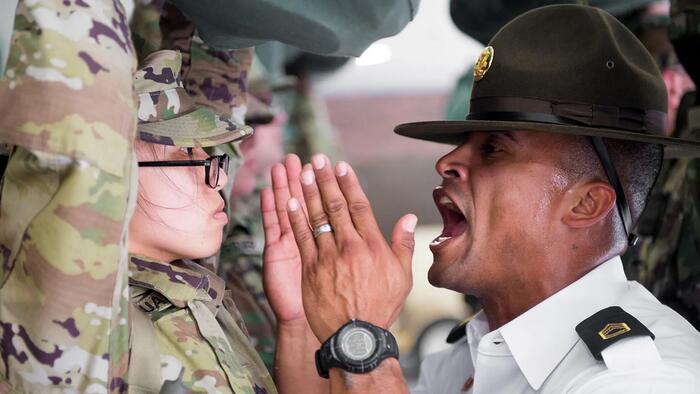Is Military Discipline the Key to Surge in US Recruitment?

Understanding the Shifts in US Military Recruitment and Training Under Recent Administrations
The landscape of military recruitment and training in the United States has undergone significant transformations in recent years, particularly during the Biden administration. From the chaotic withdrawal from Afghanistan to controversial policies surrounding discipline and diversity, these changes have captured public attention and sparked debate. As we explore the implications of these shifts, it is crucial to understand how they have impacted recruitment numbers, training standards, and the overall morale of service members.
The Chaotic Withdrawal from Afghanistan
The most glaring misstep of the Biden administration in military affairs was arguably the withdrawal from Afghanistan. The rapid collapse of the Afghan government and the ensuing chaos at Kabul’s airport highlighted severe lapses in planning and execution. This event not only tarnished the reputation of the military but also raised questions about the efficacy of leadership within the Department of Defense (DoD).
The aftermath of the withdrawal had immediate repercussions. Public interest in military service declined sharply as potential recruits witnessed the disarray and perceived lack of direction. The events in Afghanistan served as a stark reminder of the importance of strategic planning and preparedness in military operations.
Controversial Recruitment Strategies
In an effort to appeal to a more diverse demographic, military recruitment strategies shifted dramatically. Many recruitment ads adopted a tone and style that leaned heavily into progressive values, often referred to as "woke" policies. This included promoting diversity, equity, and inclusion (DEI) initiatives at the forefront of military marketing. Critics argue that this focus detracted from the fundamental purpose of the military—national defense.
For instance, recruitment advertisements that showcased cartoons and light-hearted themes were seen as trivializing the serious nature of military service. Traditional demographics that historically filled recruitment quotas, particularly young white men, found themselves notably absent from these promotional materials. This exclusion raised concerns about whether these efforts were genuinely aimed at broadening participation or simply fulfilling a political agenda.
The Impact of COVID-19 Vaccination Mandates
Another controversial aspect of military policy during this period was the mandate for COVID-19 vaccinations among service members. This policy not only created division among troops but also led to increased resignations and hesitance among potential recruits. Many viewed the vaccination mandate as an overreach, further alienating those who might have otherwise been interested in joining the ranks of the military.
Recruitment Numbers Plunge
As a direct result of these policies and public perceptions, military recruitment numbers began to decline sharply. The Army, Navy, and Air Force all reported struggles to meet their recruitment goals, with many branches missing targets by significant margins. The declining interest in military service raised alarms about the future readiness and capability of the armed forces.
Changes to Basic Training Standards
In addition to recruitment strategies, the Biden administration's approach to training standards also came under scrutiny. Significant changes were made to traditional discipline practices in basic training. Methods such as the "bay toss" and the "shark attack," which were historically used to build resilience and toughness among recruits, were deemed too harsh and were subsequently removed. This led to what many referred to as the "wimpification" of the military.
Moreover, bans on profanity and strict disciplinary measures in training environments raised questions about the effectiveness of preparing recruits for the realities of military life. Critics argued that without these time-honored traditions, recruits might not develop the mental toughness necessary for combat situations.
Reversing Course: A Push for Traditional Standards
With the changing tides of leadership, there has been a push to revert to traditional standards of training and discipline. Defense Secretary Pete Hegseth has been vocal about reinstating rigorous training methodologies that emphasize good order and discipline. His commitment to "going back to basics" reflects a desire to restore the military's foundational principles amid the chaos of recent years.
Hegseth's remarks highlight the belief that effective training must prepare recruits for the harsh realities of combat. The reinstatement of traditional methods aims to forge stronger service members who can handle the pressures of military life, ultimately enhancing overall operational readiness.
Surge in Recruitment Following Leadership Changes
With the exit of Biden and the subsequent leadership transition, there has been a notable uptick in military recruitment. Recent reports indicate that the Army met its quotas four months ahead of schedule, while the Navy and Air Force also saw increases in volunteer numbers. This resurgence has led to speculation about the factors driving this change.
While some media outlets attempted to attribute this surge to Biden's funding incentives, many veterans and military analysts argue that the decline in recruitment levels during Biden's presidency was due to the very policies that were later reversed. The return to traditional training standards and a renewed focus on military readiness seem to have resonated with potential recruits, fostering a sense of patriotism and duty.
The Role of Military Culture in Recruitment
The culture within the military plays a critical role in attracting and retaining recruits. Many current and former service members view the intense experiences of basic training, including the "shark attacks," as rites of passage. These experiences not only build camaraderie but also instill a sense of pride and accomplishment. The removal of such traditions risks alienating potential recruits who seek authenticity and a connection to the military’s storied past.
Conclusion: The Future of Military Recruitment and Training
The trajectory of military recruitment and training in the United States is a reflection of broader societal changes and political ideologies. The Biden administration's approach, focused on progressive policies and a departure from traditional standards, raised concerns about the military's effectiveness and readiness. However, with new leadership and a renewed emphasis on discipline and training, there is hope for a revival in public trust and interest in military service.
As we look to the future, it remains essential to balance progressive values with the foundational principles that have long defined the U.S. military. The question now is whether the military can adapt to contemporary challenges while maintaining its core mission of national defense. Will the military be able to inspire a new generation of recruits, or will the polarizing nature of current policies continue to deter potential volunteers?
FAQs
What were the major changes in military recruitment during the Biden administration?
During the Biden administration, military recruitment saw a significant decline due to a focus on progressive policies, the COVID-19 vaccination mandate, and a shift away from traditional training methods. These changes alienated many potential recruits and raised concerns about the military's readiness.
How did the withdrawal from Afghanistan impact military recruitment?
The chaotic withdrawal from Afghanistan led to a loss of confidence in military leadership and strategy, contributing to a sharp decline in public interest in military service. Prospective recruits witnessed the disarray and questioned the effectiveness of joining the armed forces.
What training methods were removed during this period, and why?
Traditional training methods such as the "bay toss" and "shark attack" were removed as part of a broader effort to soften military training standards. Critics argued that these changes undermined the development of mental toughness and resilience among recruits.
The shifts in military recruitment and training reflect broader societal trends and political ideologies. As the military navigates these changes, the challenge remains to inspire a new generation of recruits while maintaining its core mission of national defense. Can the military find the right balance? #MilitaryRecruitment #DefensePolicy #LeadershipChange
Published: 2025-08-19 03:00:00 | Category: Trump GNEWS Search



